-
 May 9, 2025 // Laser Focus Worldattosecond XUV laser triggers smallest, shortest dance of electrons ever recorded
May 9, 2025 // Laser Focus Worldattosecond XUV laser triggers smallest, shortest dance of electrons ever recordedThe May cover of LaserFocusWorld magazine features two familiar faces. Mattias Kling and Shubhadeep Biswas can be seen in one of their laboratories, beaming at the readers. Shubhadeep Biswas is now an assistant physics professor at the Indian Institute of Science, Bengaluru in India. Matthias Kling is the director of the Science and R&D Division at Linac Coherent Light Source (LCLS) at SLAC National Accelerator Laboratory and professor of photon science at Stanford University.
In the May issue of the magazine, the two report on their research on how they use the measurement methods of attosecond physics to gain insight into nanoplasmonics.
-
 April 9, 2025 // ACS Central Scienceelectric-field molecular fingerprinting to probe cancer
April 9, 2025 // ACS Central Scienceelectric-field molecular fingerprinting to probe cancerLaser-based infrared fingerprinting emerges as a new tool for assessing whether an individual has cancer through blood-based spectroscopic measurements. The cover image illustrates experimentation by an ultrashort laser light pulse (in the central display), revealing a unique molecular fingerprint that correlates with diverse health states, visually represented by differing colors of the inner glow of the depicted figures.
Cover art: Sama Aljarhi
-
 July 16, 2024 // Cell Reports Medicineplasma infrared fingerprinting with machine learning enables single-measurement multi-phenotype health screening
July 16, 2024 // Cell Reports Medicineplasma infrared fingerprinting with machine learning enables single-measurement multi-phenotype health screeningEissa et al. apply infrared molecular fingerprinting on a population-based cohort to report on human health from a small drop of blood plasma. The study highlights the potential of in vitro infrared spectroscopy to efficiently identify a range of chronic health conditions. The cover image symbolizes the illumination of a blood drop, revealing a unique molecular fingerprint that correlates with diverse health states.
Cover art: Sama Aljarhi (www.samaalj.com)
-
 March 26, 2024 // Nano LettersFar-Field Petahertz Sampling of Plasmonic Fields
March 26, 2024 // Nano LettersFar-Field Petahertz Sampling of Plasmonic FieldsThe response of metal nanostructures to optical excitation leads to localized surface plasmon (LSP) generation with nanoscale field confinement driving applications in, for example, quantum optics and nanophotonics. Field sampling in the terahertz domain has had a tremendous impact on the ability to trace such collective excitations. Here, we extend such capabilities and introduce direct sampling of LSPs in a more relevant petahertz domain. The method allows to measure the LSP field in arbitrary nanostructures with subcycle precision. We demonstrate the technique for colloidal nanoparticles and compare the results to finite-difference time-domain calculations, which show that the build-up and dephasing of the plasmonic excitation can be resolved. Furthermore, we observe a reshaping of the spectral phase of the few-cycle pulse, and we demonstrate ad-hoc pulse shaping by tailoring the plasmonic sample. The methodology can be extended to single nanosystems and applied in exploring subcycle, attosecond phenomena. Here is also a news item on the subject: "how do nanoparticles radiate?"
Illustration: RMT.Bergues
-
 February 22, 2024 // Analytical Chemistryprobing Blood Plasma Protein Glycosylation with Infrared Spectroscopy
February 22, 2024 // Analytical Chemistryprobing Blood Plasma Protein Glycosylation with Infrared SpectroscopyIn their latest article published in Analytical Chemistry the BIRD-team observed the glycosylation patterns of blood plasma proteins using infrared spectroscopy. The scientists started from a blood plasma sample symbolized here with a drop of blood and separated the proteins therein using ion-exchange chromatography. As the fractions elute from the chromatographic column, the team recorded their infrared molecular fingerprints, which carry information about protein structure and post-translational modifications, in particular, glycosylation. The aim is to make plasma protein glycosylation analysis robust and accessible, bringing it closer to clinical applications.
Cover image: Dennis Luck & Alexander Gelin
-
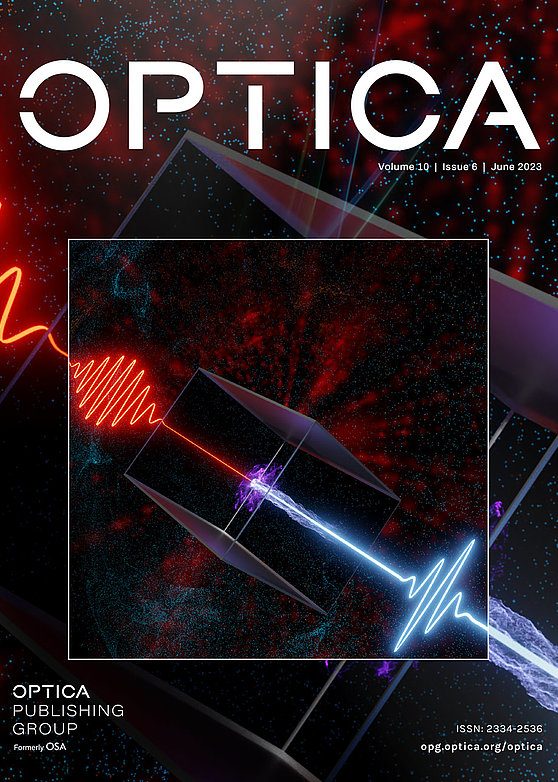 June 22, 2023 // OpticaCEP-stable single-cycle pulses on the months cover of Optica
June 22, 2023 // OpticaCEP-stable single-cycle pulses on the months cover of OpticaLaser research from the attoworld team dedicated to field-resolved infrared spectroscopy (https://www.attoworld.de/fris.html) is highlighted on the cover of this months issue of the journal Optica. The illustration shows the compression of a 2.2-µm pulse to single-cycle duration by extreme spectral broadening in a titanium dioxide (rutile) plate.
The new laser system is based on a low-noise, diode-pumped laser oscillator with Cr:ZnS as the gain medium. Nonlinear optical simulations (software package available under https://github.com/) provided insight into the remarkable compression process in titanium dioxide, as artistically captured by the illustration: the incoming beam experiences strong self-focusing, leading in an interplay with plasma formation to filament-like propagation through the crystal. This effect maintains the beam at a small diameter and high intensity over several hundred micrometers distance. As a result, the pulses are subject to strong self-phase modulation and self-compression, leading to the exceptional spectral broadening to super-octave bandwidth that allows to generate the single-cycle output pulses. When approaching such short pulse durations, it becomes essential to control the phase of the light field under the pulse envelope (carrier envelope phase, CEP).
Cover picture by: RMT.Bergues
-
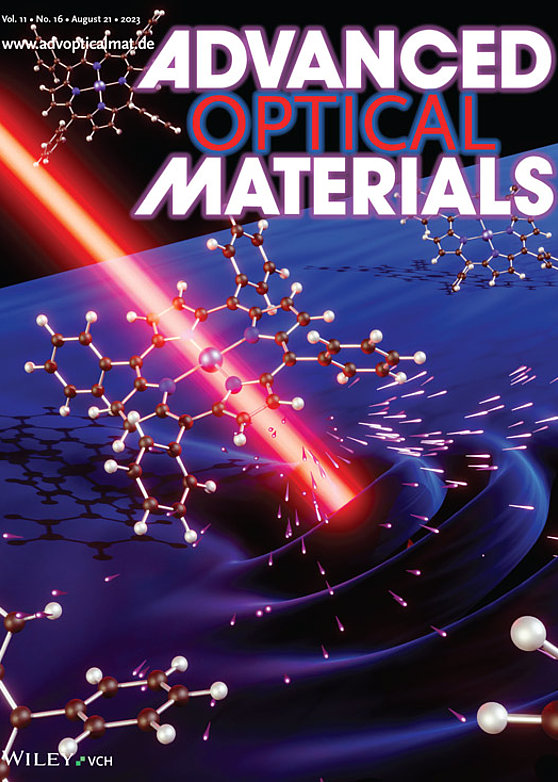 May 21, 2023 // Advanced Optical Materialsresonance effect in Brunel harmonic generation in thin film organic semiconductors
May 21, 2023 // Advanced Optical Materialsresonance effect in Brunel harmonic generation in thin film organic semiconductorsWeiwei Li, Zilong Wang, and co-workers present a study on Brunel harmonic generation in thin-film organic semiconductors exposed to intense ultrashort laser excitation. The authors find that resonant transitions induced by low-energy photons can substantially change the nonlinear behavior of the materials manifesting as an early onset of non-perturbative harmonic generation. In the image the emitted harmonics from the organic semiconducting molecules are represented both as waves and particles.
Cover picture by: RMT.Bergues
-
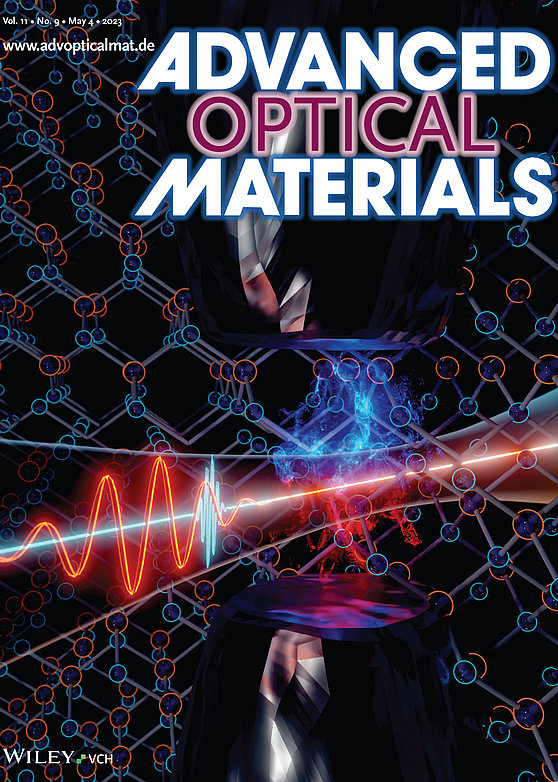 May 9, 2023 // Advanced Optical Materialsambient measurement of NIR waveforms via UV light
May 9, 2023 // Advanced Optical Materialsambient measurement of NIR waveforms via UV lightThe ability to directly measure the electric field of light enables novel observations of light-matter interactions, proving a powerful tool in modern ultrafast science. In this framework, the attoworld team applied an ultrashort visible-UV pulse to a common semiconductor. The pulse caused an appreciable change in the carrier density within the semiconductor, lasting for a few femtoseconds. This change in carrier density was harnessed as a gating event, which enabled the team to detect the electric field of a Near infrared test pulse spanning one octave from 110 to 220 THz.
The results were featured on the cover of the magazine Advanced Optical Materials (11, 202202994; 2023). The picture shows an artistic view of photoconductive sampling of optical light fields in gallium phosphide. Ultrashort ultraviolet pulses (blue line) generate electrons (blue cloud) and holes (red cloud) that are accelerated towards electrodes with the optical field (red line). The measured current in the material enables sampling of the waveform of the optical field.
Cover picture by: RMT.Bergues
-
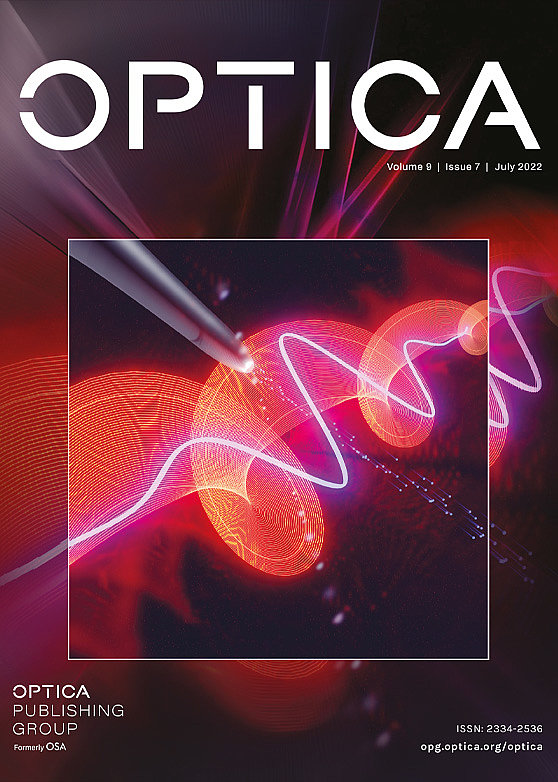 July 20, 2022 // Opticaphotographing a light helix
July 20, 2022 // Opticaphotographing a light helixWith their newly developed "nanoTIPTOE" technique, physicists from the Max Planck Institute of Quantum Optics and the Ludwig Maximilian University of Munich, in cooperation with Stanford University, have managed for the first time to record a helical light field on shortest time and length scales.
Image: A nanometric needle tip interacting with a few-cycle femtosecond laser pulse and a near-petahertz vortex field. The femtosecond pulse induces an ultrashort current of electrons that escape from the tip. The vortex field is probed by measuring the change in the electron current it induces. The localized field enhancement at the tip of the needle facilitates the spatial resolution of the helicoid wave front of the vortex field within the laser focus.
Cover picture by: RMT.Bergues
-
 May 23, 2022 // Opticalight-controlled reactions at the nanoscale
May 23, 2022 // Opticalight-controlled reactions at the nanoscaleAn international team led by Dr. Boris Bergues and Prof. Matthias Kling at Ludwig-Maximilians-Universität (LMU) and the Max Planck Institute of Quantum Optics (MPQ) in collaboration with Stanford University has now determined for the first time the location of light-induced molecular reactions on the surface of isolated silicon dioxide nanoparticles using ultrashort laser pulses.
The illustration of this work made it on the cover of OPTICA. It shows a nanoparticle in the field of a femtosecond laser pulse with tailored waveform and polarization. The controlled enhancement of the field in specific nanoscopic regions of the nanoparticle (yellow spots) induces site-selective photochemical reactions of the molecules adsorbed on the surface. Imaging of the molecular fragments emitted from these regions enables all-optical control of the reaction sites with nanometer resolution.
Cover picture by: RMT.Bergues
-
 April 21, 2021 // Angewandte Chemiea snapshot of blood serum composition
April 21, 2021 // Angewandte Chemiea snapshot of blood serum compositionA snapshot of blood serum composition reflects the health state of an individual. It can be obtained using infrared spectroscopy in a simple and inexpensive manner, but the molecular nature of the disease-related changes therein remains poorly understood. In their Research Article published in Angewandte Chemie Int. Ed. in June 2021, Liudmila Voronina, Mihaela Žigman et al. used proteomics to reveal a set of proteins that contribute the most to infrared absorption of blood serum and show that they create a distinct signature of lung cancer. The cover image was conceived by the respective authors and illustrated by Dennis Luck.
Cover illustration: Dennis Luck
-
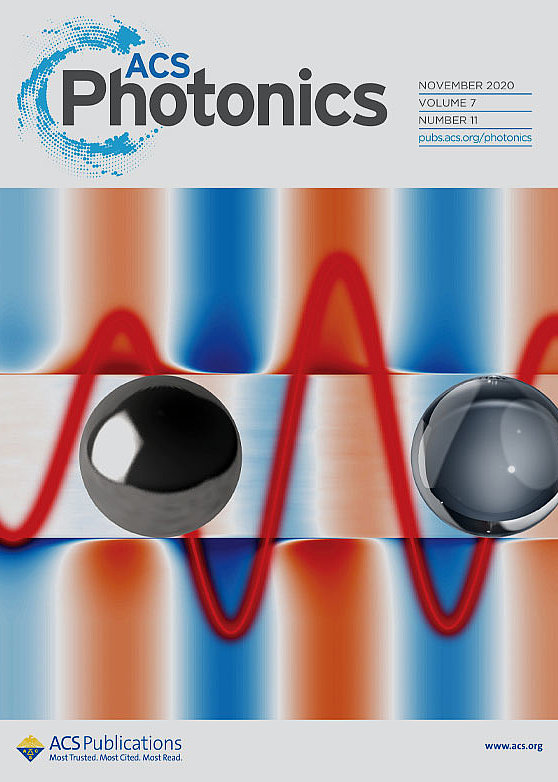 October 23, 2020 // ACS Photonicsultrafast metallization
October 23, 2020 // ACS Photonicsultrafast metallizationThe article "Ionization-Induced Sub-cycle Metallization of Nanoparticles in Few-Cycle Pulses" by Qingcao Liu et al. was featured on the cover of ACS Photonics in the November 2020 issue. The cover was designed by Qingcao Liu with support by Lennart Seiffert and Matthias Kling, and shows the metallization of nanoparticles in few-cycle laser pulses. The hallmarks for the metallization are a phase change between inner and outer fields (depicted in false color), the screening of inner fields, and a characteristic increase in the cutoff energy of emitted electrons.
-
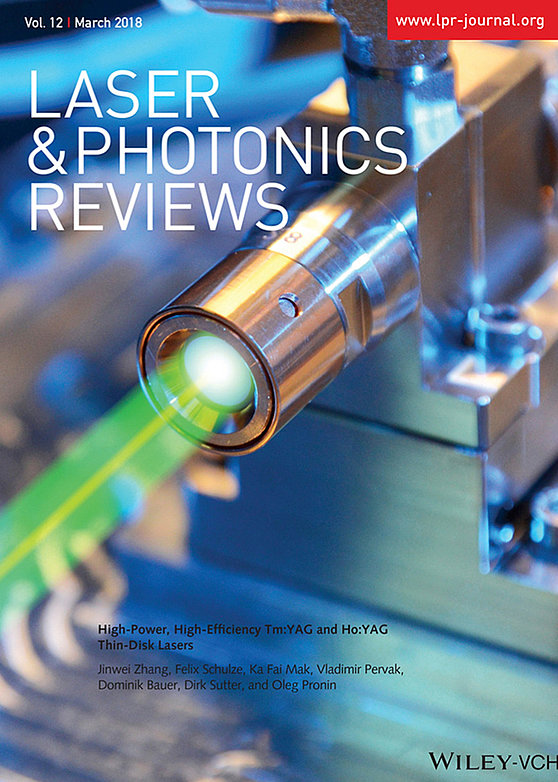 March 26, 2018 // Laser & Photonics Reviewsinfrared lasers
March 26, 2018 // Laser & Photonics Reviewsinfrared lasersIn article number 1700273, Jinwei Zhang and co‐workers investigate two different gain materials, Tm:YAG and Ho:YAG, in thin‐disk configuration. Using a 72‐pass pump cavity, thin‐disk lasers with high powers and optical‐to‐optical efficiencies at 2 µm are realized, paving the way for further scaling of power towards kW‐level based on thin‐disk technology. The image was made and processed by Thorsten Naeser, Dennis Luck, and Kilian Fritsch together with the authors of this manuscript.
Cover image: Dennis Luck & Thorsten Naeser
-
 March 8, 2018 // Nature Physicsprominently placed
March 8, 2018 // Nature Physicsprominently placedA paper written by Drs. Yuya Morimoto and Peter Baum of the Laboratory for Attosecond Physics, which is jointly run by LMU Munich and the Max Planck Institute for Quantum Optics, is featured on the cover of the March 2018 issue of Nature Physics. Its authors have developed a novel form of electron microscopy, which allows light-matter interactions to be observed in real time at atomic resolution. The new method thus makes it possible to visualize atomic processes as they unfold in space and time. In the experiments described in the report, the Munich researchers make use of the oscillating electric field of laser light to ‘chop’ an electron beam into a sequence of attosecond pulses. By focusing the pulse trains on a silicon crystal, they were able to observe, in real time, how the electromagnetic waveform propagates within the crystal, as well as the relationship between the diffraction of the electrons by atoms in the crystal and the phase of the optical field. The cover picture shows a superimposition of data obtained from a set of time-delayed measurements, and reveals how the Bragg-reflections that make up the diffraction pattern change when varying the delay of the light-cycle excitation.
-
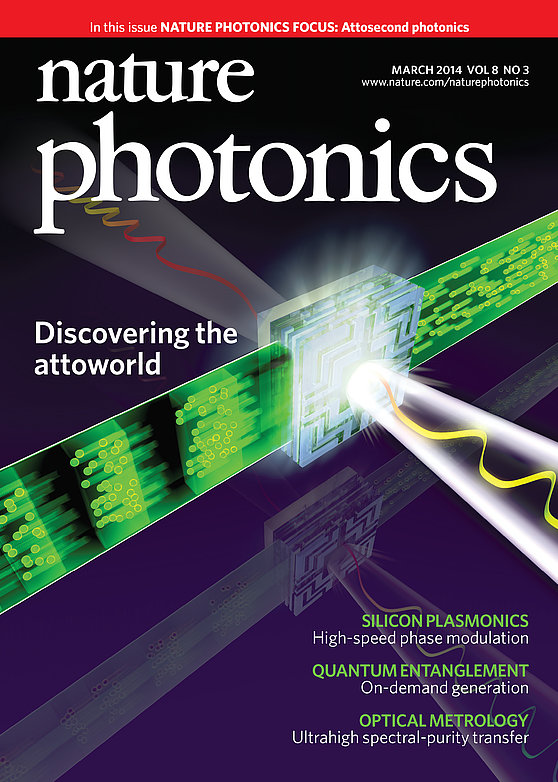 March 1, 2014 // Nature Photonicssignal control with light frequencies
March 1, 2014 // Nature Photonicssignal control with light frequenciesLight waves have the potential to boost the efficiency of conventional electronics by a factor of 100,000. In a review article that appears in »Nature Photonics« on March 14th, Prof. Ferenc Krausz of the Laboratory for Attosecond Physics (LAP) at the Max-Planck-Institut für Quantenoptik and the Ludwig-Maximilians-Universität München and his co-author Prof. Mark Stockman of Georgia State University (GSU) in Atlanta describe how this vision may one day come true. In their scenario, one would exploit the electric field of laser light to control the flow of electrons in dielectric materials, which, in turn, may modulate transmitted light and switch current in electronic circuits at light frequencies. Visible light oscillates at frequencies of about 1015 cycles per second, opening the possibility of switching light or electric current at rates in this range. And since both signals can also carry information, innovative optoelectronic technologies would enable a corresponding increase in the speed of data processing, opening a new era in information technology. The authors review the novel tools and techniques of attosecond technology, which may play a crucial role in making the above advances actually happen.
-
 November 1, 2013 // Wiley-VCHUltraschneller Tauchgang in die Atome
November 1, 2013 // Wiley-VCHUltraschneller Tauchgang in die AtomeIn 2001, when scientists around Prof. Ferenc Krausz for the first time succeeded to produce light flashes which only lasted attoseconds, a new era was ushered in natural sciences. Attosecond physics was born. Now, it should be possible to observe electrons and hence wrench the microcosm one of its most closely guarded secrets. In his book Ultraschneller Tauchgang in die Atome, Thorsten Naeser, head of press and public relations within the cluster of excellence Munich-Centre for Advanced Photonics (MAP), talks about the development of attosecond physics. Building upon the basics of quantum mechanics, laser physics and chronophotography, Thorsten Naeser describes how electrons can be captured in images today: with light flashes which last only a few billionth of a billionth second. Thorsten Naeser also picturesquely describes numerous results attosecond physics has brought to this day and where the road of exploring quantum particles may lead. The book is written in German.
-
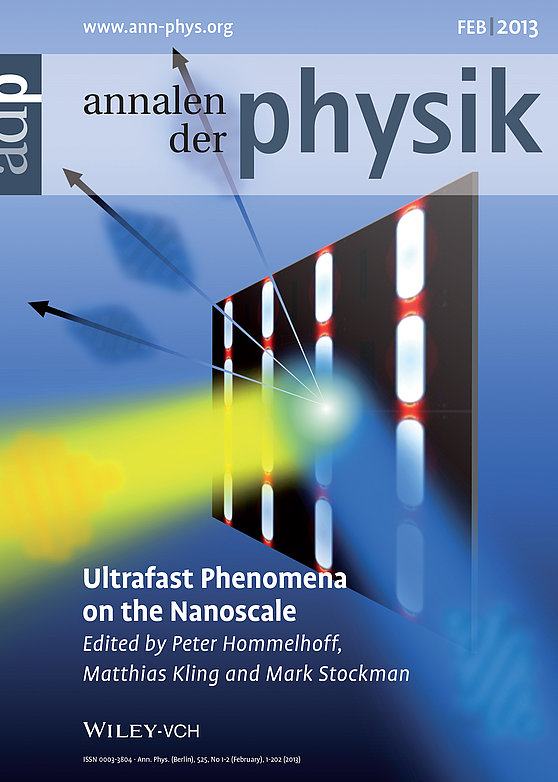 February 1, 2013 // Annalen der Physikultrafast phenomena on the nanoscale
February 1, 2013 // Annalen der Physikultrafast phenomena on the nanoscaleThe fast paced field of ultrafast nanoscience exploits both ultrafast optics and nanostructuring techniques to explore new phenomena, ranging from plasmonic coupling of light and matter to attosecond physics. The special issue edited by Peter Hommelhoff, Matthias Kling and Mark Stockman, highlights the recent rapid progress in the field. Ultrafast phenomena described in the contributed articles include linear and non-linear effects over a wide range of applications including one- and multidimensional (spatially resolved) spectroscopies, time-resolved measurements of localized and propagating surface plasmons, the dynamics of nanostructures in ultrashort and ultrastrong fields, the ultrafast emission of electrons, the coherent generation of light including high-harmonic generation, and nanoscale devices, which contribute to the development of ultrafast nanoscale electronics.
-
 December 10, 2012 // Applied Physics Lettersa laser-driven nanosecond proton source for radiobiological studies
December 10, 2012 // Applied Physics Lettersa laser-driven nanosecond proton source for radiobiological studiesIon beams are relevant for radiobiological studies and for tumor therapy. In contrast to conventional accelerators, laser-driven ion acceleration offers a potentially more compact and cost-effective means of delivering ions for radiotherapy. Here, Jianhui Bin and co-workers show that by combining advanced acceleration using nanometer thin targets and beam transport, truly nanosecond quasi-monoenergetic proton bunches can be generated with a table-top laser system, delivering single shot doses up to 7Gy to living cells. Although in their infancy, laser-ion accelerators allow studying fast radiobiological processes as demonstrated here by measurements of the relative biological effectiveness of nanosecond proton bunches in human tumor cells.
-
 November 1, 2012 // Review of Scientific Instrumentsinvited article: attosecond photonics: synthesis and control of light transients
November 1, 2012 // Review of Scientific Instrumentsinvited article: attosecond photonics: synthesis and control of light transientsUltimate control over light entails the capability of crafting its field waveform. Here, Mohammed Th. Hassan and co-workers describe in an invited article the technological advances that have recently permitted the synthesis of light transients confinable to less than a single oscillation of its carrier wave and the precise attosecond tailoring of their fields. The work opens the door to light field based control of electrons on the atomic, molecular, and mesoscopic scales. The team presents the technology of what is believed to be a new realm in light control: the synthesis of subcycle transients of the electromagnetic field and the attosecond tailoring of its waveform. Whereas subcycle field synthesis requires the manipulation of coherent, superoctave light sources, its successful implementation is compatible with the subdivision of this bandwidth into a limited number of constituent spectral channels as long as dispersion affective of the pulses in each of these channels is possible. The light fieldsynthesis concepts detailed in this work also affords scalability over several more optical octaves by the introduction of additional spectral channels in the deep and vacuum ultraviolet, as well as in the infrared region of the spectrum.
-
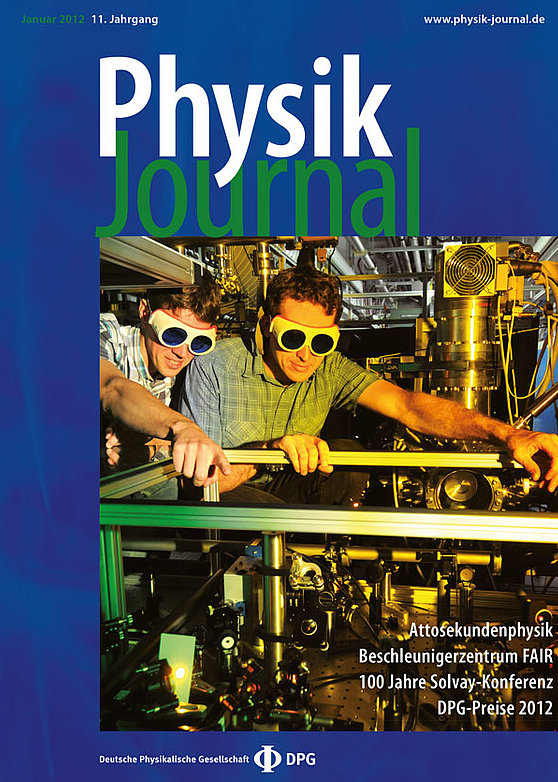 January 1, 2012 // Physik JournalElektronen unter Kontrolle
January 1, 2012 // Physik JournalElektronen unter KontrolleWith the help of ultrashort light pulses, electrons in molecules and nanostructures can be controlled and observed on attosecond time scales. While the atomic nuclei in molecules and nanostructures typically move on a femtosecond time scale, the dynamics of the much lighter electrons run around a thousand times faster on an attosecond time scale, i.e. 0,000,000,000,000,000,001 seconds! Nevertheless, new techniques make it possible to control these movements and to film them. This promises the targeted control of chemical reactions or purely optical circuits. Matthias Kling and Marc J.J. Vrakking explain the latest developments in attosecond physics. (Article in German)
-
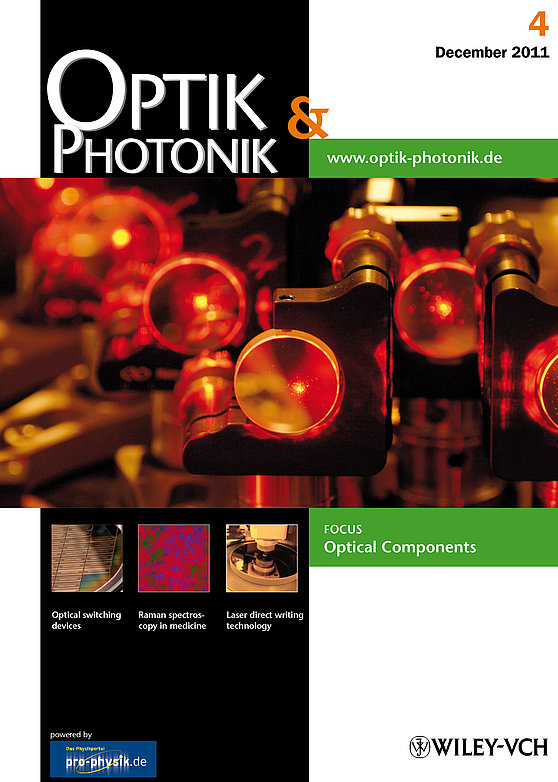 December 1, 2011 // Optik and Photonikattosecond physics – the first decade. On the route to tiny time scales
December 1, 2011 // Optik and Photonikattosecond physics – the first decade. On the route to tiny time scalesDeep inside matter, our ideas of time lose their validity. Light flashes which last only a few millionths to billionths of a billionth second snatch from the microcosm its closely guarded secrets: Electron movements become visible. Quantum phenomena can be examined in real time. The control of elementary particles comes within reach. Responsible for all that is the young science of attosecond physics, "born" in 2001, when Prof. Ferenc Krausz succeeded in producing and measuring light flashes which last less than one femtosecond. Krausz founded the Laboratory for Attosecond Physics (LAP) which is located at the Max Planck Institute for Quantum Optics in Garching, Germany. Here is the history of how Attosecond Physics has been developed in LAP over the last ten years.
-
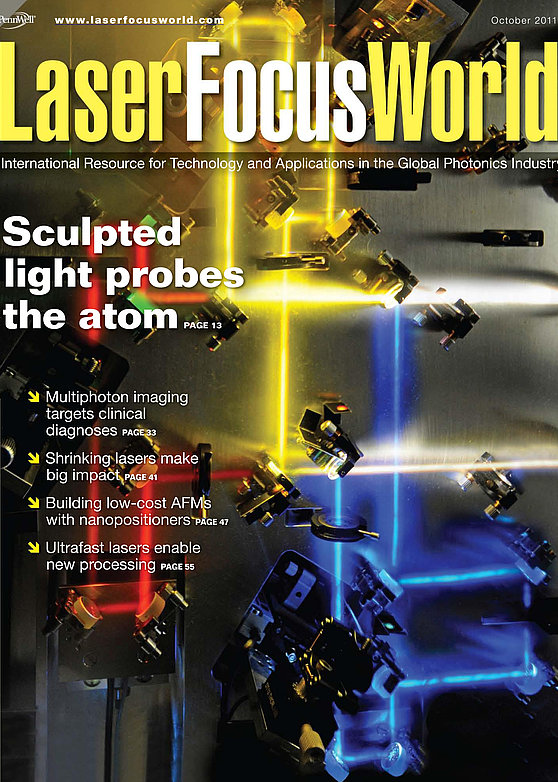 October 1, 2011 // Laser Focus Worldsub-femtosecond sculpted light transients probe the atom
October 1, 2011 // Laser Focus Worldsub-femtosecond sculpted light transients probe the atomAttosecond (as) photonics is a rapidly developing tool to help scientists study the behavior of matter and energy at this extraordinarily short time scale. Now, the research group around Dr. Eleftherios Goulielmakis, lead researcher with the Max Planck Institute for Quantum Optics has reached a new milestone: the shaping and attosecond sampling of »light transients« within a 2.4 fs time span over a 0.3–0.9 PHz frequency range. Light transients are nonrepeating sculpted waveforms that are completely confined to a single cycle, or at most a few cycles. On-demand waveforms with customized field evolution and sub-femtosecond rise times and confinements are now possible with petahertz-scale field synthesis. These shaped transients allow physicists to probe the properties of electron behavior within atoms with great detail.
-
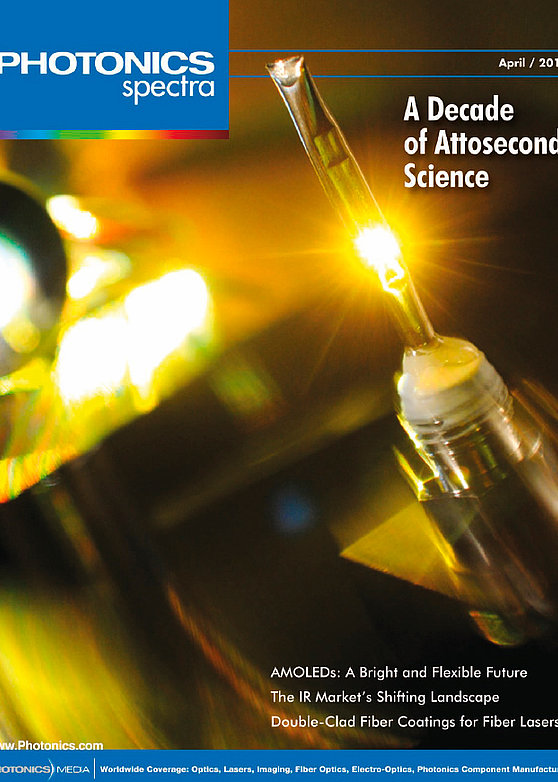 April 1, 2011 // Photonics Spectraa decade in attosecond science
April 1, 2011 // Photonics Spectraa decade in attosecond scienceThe year 2011 marks the 10th anniversary of an important advance in ultrafast laser pulses: For the first time, laser physicists were able to break the femtosecond barrier to create attosecond pulses – the shortest light pulses ever generated in the laboratory. The first single isolated pulses lasting for less than 1 fs (measured at 650 as) were produced in 2001 by Dr. Reinhard Kienberger and professor Ferenc Krausz and his group at the Vienna University of Technology in Austria. Today, Krausz is director of the Max Planck Institute of Quantum Optics and professor at Ludwig Maximilian University, both in Munich, Germany.
-
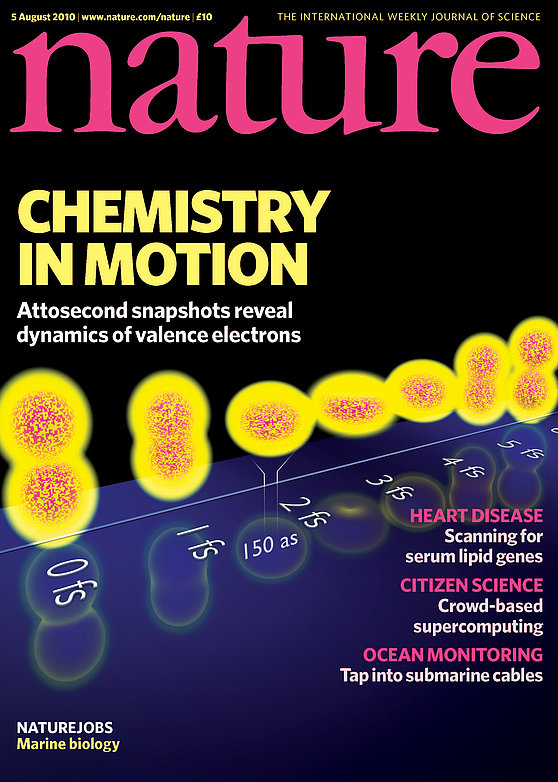 August 5, 2010 // Naturereal-time observation of valence electron motion
August 5, 2010 // Naturereal-time observation of valence electron motionAn international team from the Laboratory for Attosecond Physics (attoworld.de), led by Prof. Ferenc Krausz at the Max Planck Institute of Quantum Optics and the Ludwig- Maximilians-Universität in Munich, in collaborations with researchers from the United States and Saudi Arabia, have observed, for the first time, the quantum-mechanical behaviour occurring at the location in a noble gas atom where, shortly before, an electron had been ejected from its orbit. The researchers achieved this result using light pulses which last only slightly longer than 100 attoseconds.
-
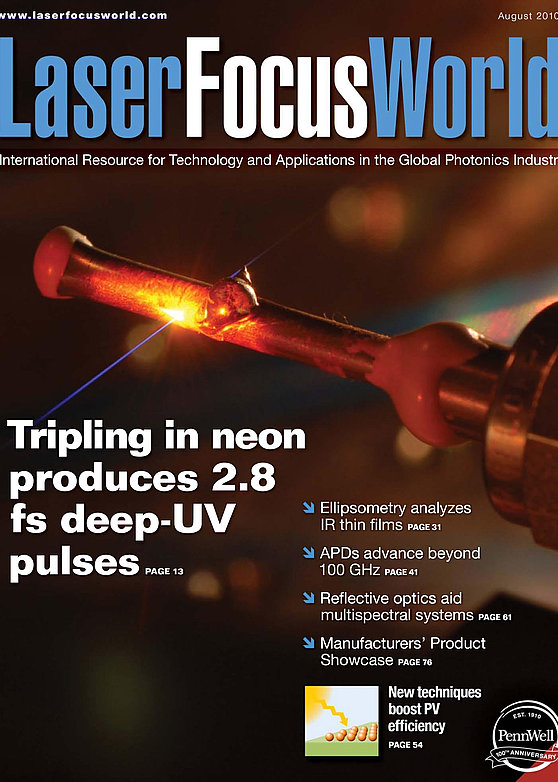 August 1, 2010 // Laser Focus Worldtripling in neon produces 2.8 fs deep-UV pulses
August 1, 2010 // Laser Focus Worldtripling in neon produces 2.8 fs deep-UV pulsesFemtosecond and attosecond light pulses are now allowing scientists to deeply explore the workings of atoms, molecules and nanoparticles, writes John Wallace in his article. For example few-cycle deep ultraviolet pulses fired at molecules can manipulate valence-shell electrons, preparing the molecules for high-resolution study via attosecond spectroscopy. Up to now, the shortest pulses created in the deep-UV range have been about 3.7 fs in duration (attosecond pulses consist of light at shorter extreme-UV wavelengths). But a direct-frequency-conversion approach developed by researchers at Max-Planck-Institut für Quantenoptik, Technische Universität München, and Ludwig-Maximilians-Universität (all of Garching, Germany) and King Saud University (Riyadh, Saudi Arabia) produces deep-UV pulses only 2.8 fs long, with pulses less than 1 fs a possibility.
-
 June 25, 2010 // Sciencedelay in photoemission
June 25, 2010 // Sciencedelay in photoemissionWhen light is absorbed by atoms, the electrons become excited. If the light particles, so-called photons, carry sufficient energy, the electrons can be ejected from the atom. This effect is known as photoemission and was explained by Einstein more than hundred years ago. Until now, it has been assumed that immediately after the impact of the photons the electrons start moving out of the atom. This point in time can be detected and has so far been considered as coincident with the arrival time of the light pulse, i.e. with "time zero" in the interaction of light with matter. Using their ultra-short time measurement technology, physicists from the Laboratory for Attosecond Physics at the Max Planck Institute of Quantum Optics (MPQ), the Ludwig-Maximilians-Universität in Munich (LMU) and the Technische Universität München (TUM), along with their collaborators from Austria, Greece, and Saudi Arabia, have now tested this assumption. Their measurements revealed that electrons excited simultaneously by a light pulse from different atomic orbitals leave the atom with a small but measurable time delay of about twenty attoseconds. One attosecond is one billionth of one billionth of a second. These new findings contradict the earlier assumption that the electrons leave the atom immediately after the light pulse has hit. The June 25th issue of Science magazine features these spectacular scientific insights on its cover.
-
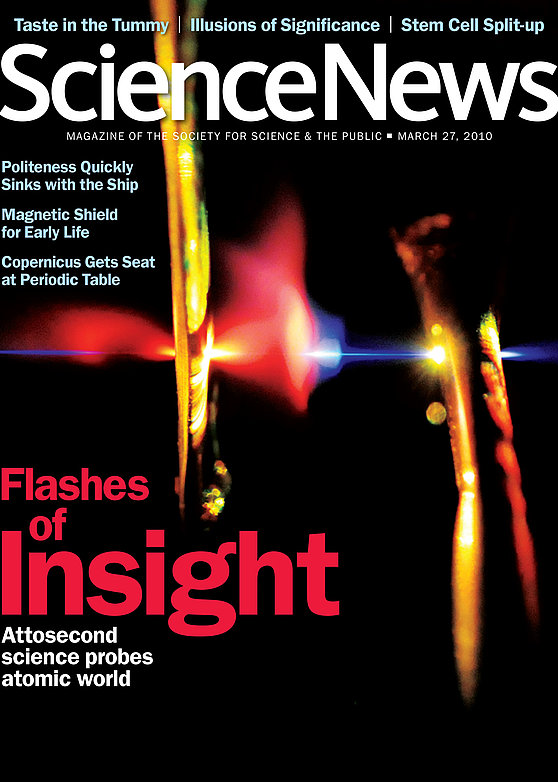 March 27, 2010 // Science Newsin pursuit of the briefest beat
March 27, 2010 // Science Newsin pursuit of the briefest beatAttosecond pulses of light could open electrons’ fast-paced world. Science writer Charles Petit tells the story of attosecond physics beginning with Paul Corkum. Corkum is a laser and plasma physicist with Canada’s National Research Council and the University of Ottawa. His vision, in 1993, led him to become a pioneer in a field of attosecond science. Charles Petitis telling a dramatic thriller around Corkum. The actors were the pulsating electric fields of ordinary infrared laser beams and the electrons of atoms in the laser’s path. As the plot unfolded, a puzzle would be resolved - opening, he realized, a new frontier in the measurement of the ultrafast and the ultrabrief.
-
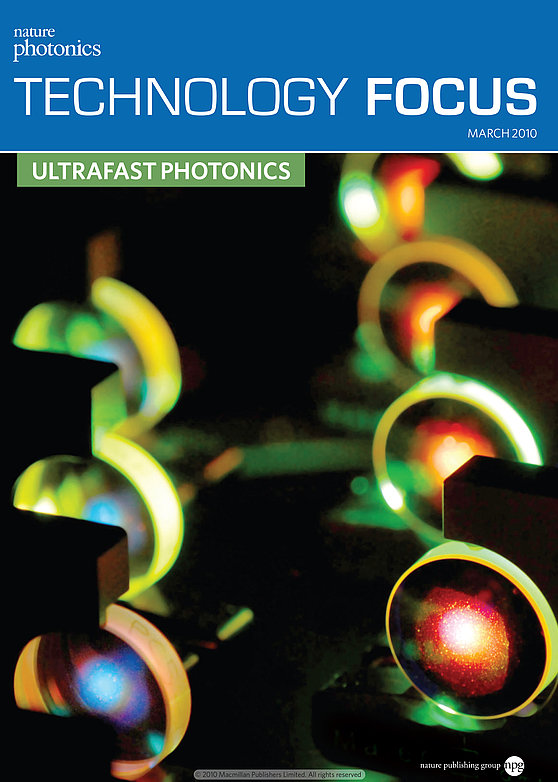 March 1, 2010 // Nature photonics technology focusoptics made to measure
March 1, 2010 // Nature photonics technology focusoptics made to measureThere is something unique about the startup company UltraFast Innovations. The company, which designs and manufactures tailor-made optics for ultrafast applications, was set up by two academic giants in the field of ultrafast optics research — the Ludwig-Maximilians-Universität München (LMU) and the Max Planck Institute of Quantum Optics (MPQ), both based in Garching, Germany. These organizations have both spun-out companies before, but this one is different — this one they own. Unlike other spin-offs, where researchers set up their own company and licence technology from their university or institute for a small stake in the company, UltraFast Innovations is owned 50:50 by LMU and MPQ. Nadya Anscombe finds out about the company’s products and its plans for the future.
-
 November 11, 2008 // Optics & Laser Europeeurope leads the way in attosecond research
November 11, 2008 // Optics & Laser Europeeurope leads the way in attosecond researchBreaking the 100 as barrier and making the first movie of electron motion are just two recent milestones achieved by European researchers. Nadya Anscombe talks to key players in the attosecond community to see what the future holds: Scientists all over the world have for many years been trying to build a camera that works on this timescale. Being able to see electronic motion in real time would open up a whole new field of science and would revolutionize the way that we see the world. Just a few years ago, scientists could only dream of such a technology, but today the impossible become reality.
-
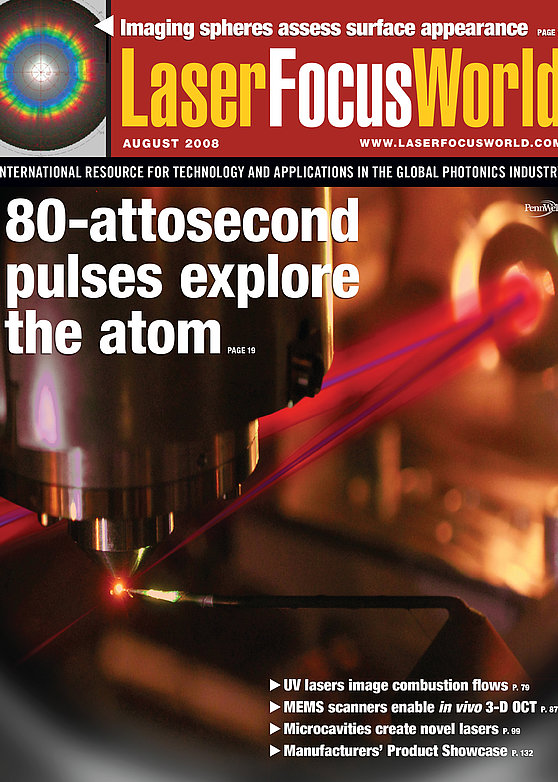 August 1, 2008 // Laser Focus Worldattosecond pulses: light to reveal electrons interacting within atoms
August 1, 2008 // Laser Focus Worldattosecond pulses: light to reveal electrons interacting within atomsBy carefully controlling the waveform of an ultrafast laser pulse and sending it through a jet of neon gas, briefly ionizing it, researchers at the Max-Planck-Institut für Quantenoptik (MPQ; Garching, Germany), the Ludwig-Maxmilians-Universität München (also in Garching), and the Lawrence Berkeley National Laboratory (Berkeley, CA) have created the shortest light pulse yet only 80 attoseconds (as) in duration. Such well-controlled photoionization will result in new science, for example by allowing direct observation of quantum-electronic correlations writes John Wallace in a featured article.
-
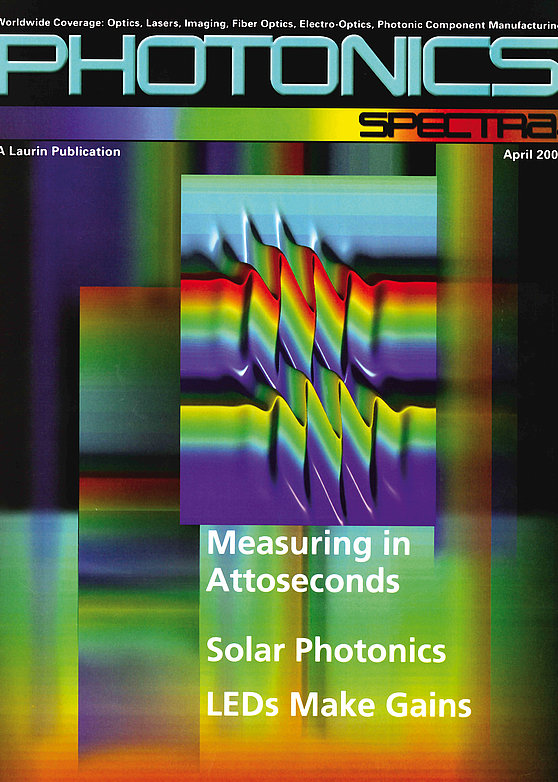 April 1, 2008 // Photonics Spectrawatching what happens during attoseconds in solids
April 1, 2008 // Photonics Spectrawatching what happens during attoseconds in solidsIn pump/probe experiments, one pulse (of light, of x-rays, of electrons, etc.) triggers a process, and another pulse with an adjustable delay probes the subsequent temporal evolution of the process. This has turned out to be the most direct approach to time-domain investigations of fast-evolving microscopic processes, writes Dr. Reinhard Kienberger in this article. Accessing atomic and molecular inner-shell relaxation processes, valence-band electron wave packet dynamics, electron-electron interactions or atomic-scale charge transport in real time requires subfemtosecond temporal resolution. The emergence of intense waveform-controlled few-cycle near-infrared laser pulses and isolated subfemtosecond extreme-ultraviolet (XUV) pulses available for pump/probe experiments has opened the door for direct time-domain access to electron motion on the atomic (i.e., subnanometer) scale. These tools, along with the technique of laser-field controlled XUV photoemission, have permitted real-time observation of intra-atomic electronic motion in several proof-of-concept experiments performed on isolated atoms in the gas phase and mark the birth of attosecond science and time-resolved atomic transient recording.
-
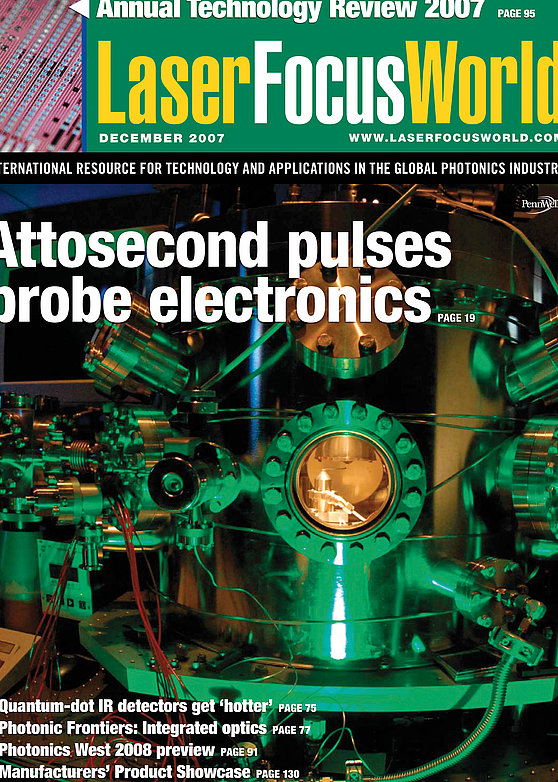 December 1, 2007 // Laser Focus Worldattosecond pulses probe electronics
December 1, 2007 // Laser Focus Worldattosecond pulses probe electronicsIn April 2007, physicists announced the attosecond-scale real-time measurement of the electron tunneling speed in neon gas using ultrashort light-pulse generation and control. Now, the attosecond envelope has again expanded with the measurement of the electron transport in a condensed-matter system—the first of its kind in a solid, according to an international research team led by Ferenc Krausz, professor of physics at the Ludwig-Maximillians-Universität München, and director of the Max-Planck-Institut für Quantenoptik (Garching, Germany). Science writer Valerie C. Coffey reports about this latest success.
-
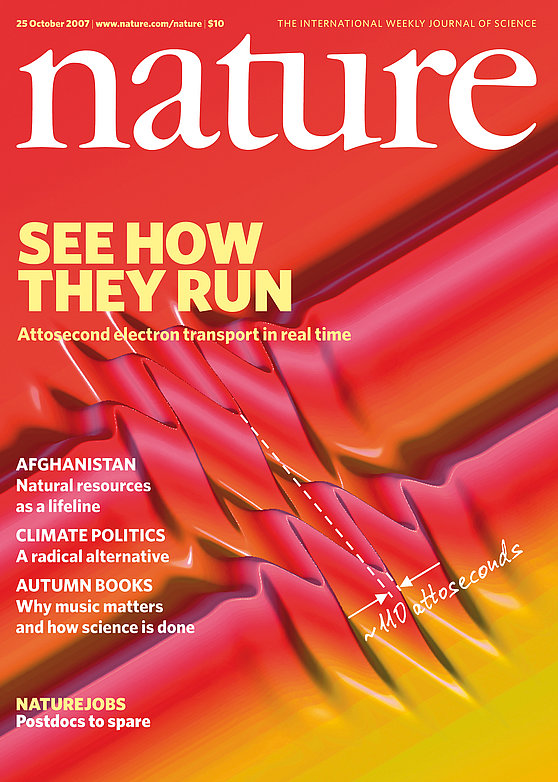 October 25, 2007 // Natureattosecond spectroscopy in condensed matter
October 25, 2007 // Natureattosecond spectroscopy in condensed matterComprehensive knowledge of the dynamic behaviour of electrons in condensed-matter systems is pertinent to the development of many modern technologies, such as semiconductor and molecular electronics, optoelectronics, information processing and photovoltaics. Yet it remains challenging to probe electronic processes, many of which take place in the attosecond (1 as = 10−18 s) regime. In contrast, atomic motion occurs on the femtosecond (1 fs = 10−15s) timescale and has been mapped in solids in real time using femtosecond X-ray sources. Here we extend the attosecond techniques previously used to study isolated atoms in the gas phase to observe electron motion in condensed-matter systems and on surfaces in real time. We demonstrate our ability to obtain direct time-domain access to charge dynamics with attosecond resolution by probing photoelectron emission from single-crystal tungsten.
-
 August 10, 2007 // Scienceattosecond control and measurement: lightwave electronics
August 10, 2007 // Scienceattosecond control and measurement: lightwave electronicsElectrons emit light, carry electric current, and bind atoms together to form molecules. Insight into and control of their atomic-scale motion are the key to understanding the functioning of biological systems, developing efficient sources of x-ray light, and speeding up electronics. Capturing and steering this electron motion require attosecond resolution and control, respectively (1 attosecond = 10−18 seconds). A recent revolution in technology has afforded these capabilities: Controlled light waves can steer electrons inside and around atoms, arking the birth of lightwave electronics. Isolated attosecond pulses, well reproduced and fully characterized, demonstrate the power of the new technology. Controlled few-cycle light waves and synchronized attosecond pulses constitute its key tools. We review the current state of lightwave electronics and highlight some future directions.
-
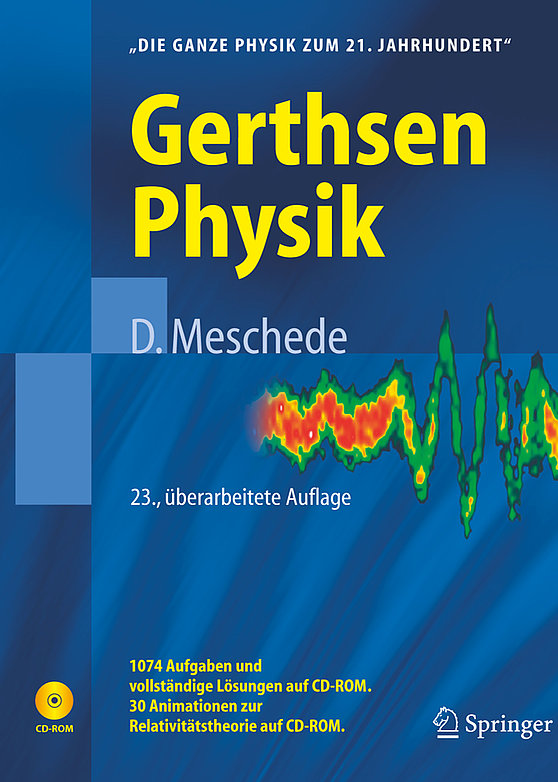 March 1, 2006 // Gerthsen PhysikDie ganze Physik zum 21. Jahrhundert
March 1, 2006 // Gerthsen PhysikDie ganze Physik zum 21. JahrhundertEditor D. Meschede released the 23. Volume of the encyclopedia Gerthsen Physik. The 23rd edition consisted of 1162 pages, contained 94 tables, 105 calculated examples and 1074 exercises with solutions as well as a CD-ROM with 30 animations to visualize the theory of relativity. As part of the "Einstein Year 2005", the chapter on relativity in particular was revised and presented in a timely manner (over long stretches with four-vectors). The entire compendium including exercises in full text is available online at many university libraries.
-
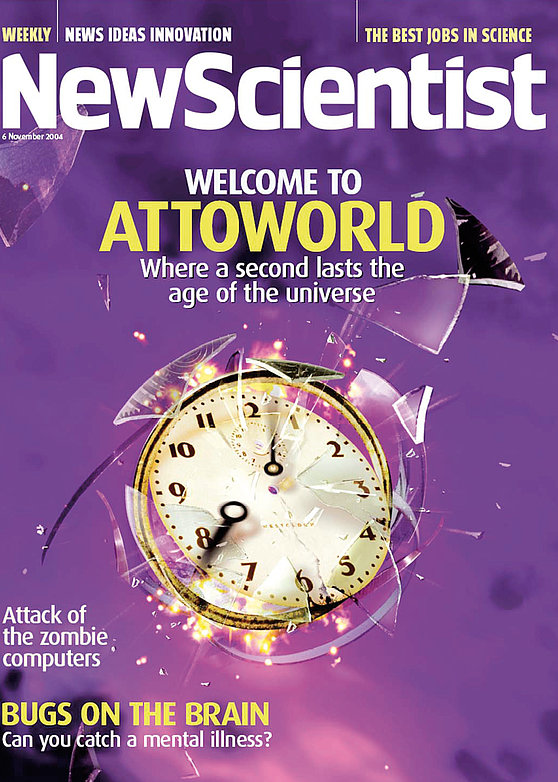 November 6, 2004 // New Scientistwelcome to attoworld
November 6, 2004 // New Scientistwelcome to attoworldThe dial on your kitchen scales spins when a virus lands. The clock on the wall has gone berserk, ticking every billionth of a billionth of a second. Your camera flashes so fast that it captures single molecules in freeze-frame. Prepare to enter attoworld, the ultra-small realm so foreign that no one quite knows what’s going on. Today’s scientists are inventing gadgets that can measure attoscale quantities, such as the mass of a virus, which is just a few attograms. They can sense attonewton forces so feeble they couldn’t lift a protein molecule. And they are designing attosecond stopwatches and attolitre test tubes. Hazel Muir zooms in new inventions finding their vocation in the head-swimmingly small attoworld.
-
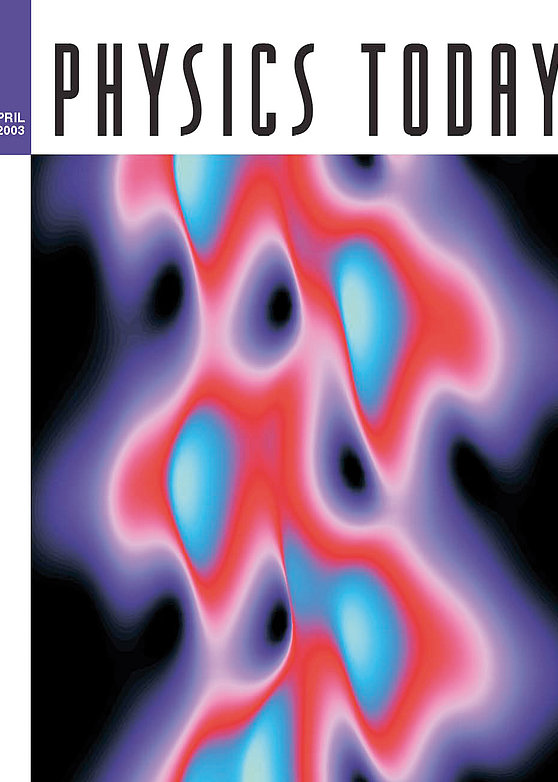 April 1, 2003 // Physics Todayultrashort laser pulses beget even shorter bursts in the extreme ultraviolet
April 1, 2003 // Physics Todayultrashort laser pulses beget even shorter bursts in the extreme ultravioletThe attophysics frontier is about to expand, thanks to the newly won ability to control the phase of amplified laser pulses. Science writer Charles Day reports about Ferenc Krausz of the Vienna University of Technology, Austria, and Theodor Hänsch of the Max Planck Institute for Quantum Optics in Garching, just north of Munich, Germany. The scientists are now able make isolated pulses of precisely controlled and reproducible shape that last a few hundred attoseconds.
-
 October 24, 2002 // Naturetime-resolved atomic inner-shell spectroscopy
October 24, 2002 // Naturetime-resolved atomic inner-shell spectroscopyThe characteristic time constants of the relaxation dynamics of core-excited atoms have hitherto been inferred from the linewidths of electronic transitions measured by continuous-wave extreme ultraviolet or X-ray spectroscopy. M. Drescher and co-workers demonstrate that a laser-based sampling system, consisting of a few-femtosecond visible light pulse and a synchronized sub-femtosecond soft X-ray pulse, allows us to trace these dynamics directly in the time domain with attosecond resolution. report about their experiments. The team has measured a lifetime of 7.9+1.0−0,9 fs of M-shell vacancies of krypton in such a pumpprobe experiment.
-
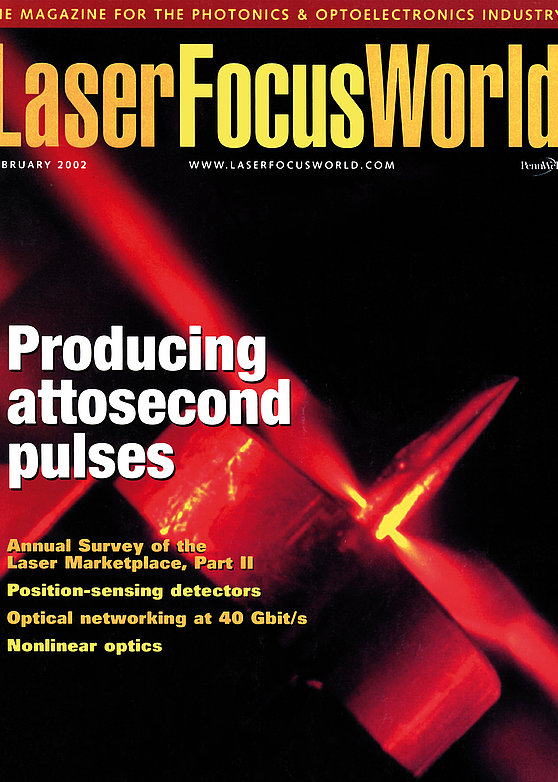 February 1, 2002 // Laser Focus Worldoptical pulses reach attosecond length
February 1, 2002 // Laser Focus Worldoptical pulses reach attosecond lengthIn the world of ultrashort optical pulses, the femtosecond (fs) has been superseded by the attosecond (as, or 10−18 s). An international collaboration of ten scientists claims to have generated and detected isolated soft x-ray pulses of 650-as duration. Scientists at the Vienna University of Technology, Austria, along with others at the National Research Centre (Ottawa, Canada) and the University of Bielefeld, Germany, have developed experimental tools and techniques that could enable attosecond-resolution spectroscopy of bound electron dynamics in atoms and molecules.
-
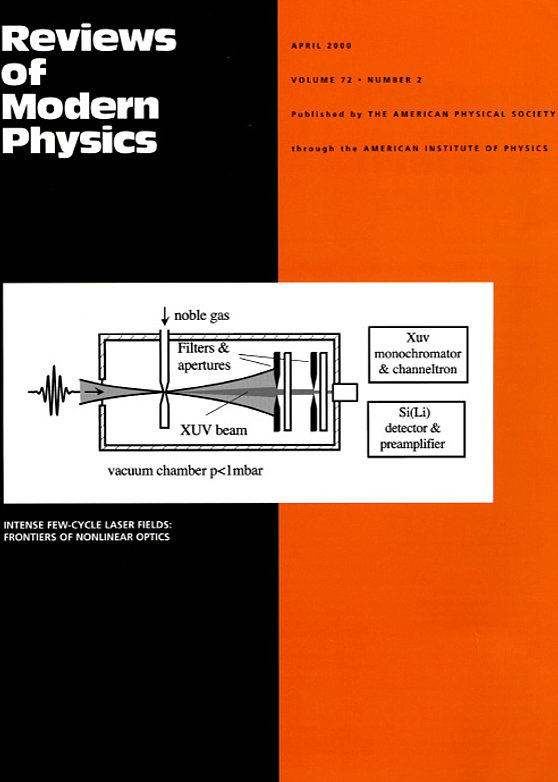 April 1, 2000 // Reviews of Modern Physicsintense few-cycle laser fields: frontiers of nonlinear optics
April 1, 2000 // Reviews of Modern Physicsintense few-cycle laser fields: frontiers of nonlinear opticsThe rise time of intense radiation determines the maximum field strength atoms can be exposed to before their polarizability dramatically drops due to the detachment of an outer electron. Recent progress in ultrafast optics has allowed the generation of ultraintense light pulses comprising merely a few field oscillation cycles. The arising intensity gradient allows electrons to survive in their bound atomic state up to external field strengths many times higher than the binding Coulomb field and gives rise to ionization rates comparable to the light frequency, resulting in a significant extension of the frontiers of nonlinear optics and (nonrelativistic) high-field physics. Implications include the generation of coherent harmonic radiation up to kiloelectronvolt photon energies and control of the atomic dipole moment on a subfemtosecond time scale. In this review Ferenc Krausz and Thomas Brabec present the landmarks of the 30-odd-year evolution of ultrashort-pulse laser physics and technology culminating in the generation of intense few-cycle light pulses and discusses the impact of these pulses on high-field physics.
-
 July 1, 1998 // Optics and Photonics Newsextreme nonlinear optics. Exposing matter to a few periods of light
July 1, 1998 // Optics and Photonics Newsextreme nonlinear optics. Exposing matter to a few periods of lightIntense light pulses in the single-cycle regime have opened up new avenues in linear optics. These, along with expected impacts on other areas of science and technology, are discussed by F. Krausz, T. Brabec, M Schnürer, and C.Spielmann. Ultrashort-pulse laser technology has progressed tremendously over the last 10 years. The invention of a new broad-band laser medium, titanium-doped sapphire, a novel ultrafast mode-locking technique dubbed Kerr-lens mode-locking, and a powerful device for ultrabroad-band dispersion control – chirped multilayer mirrors – for the first time opened the way to a reliable sub-10-fs laser technology. Drawing on the concept of chirped-pulse amplification, Ti:sapphire laser systems are now capable of generation pulses of around 20 fs in duration with millijoule energies (yielding peak powers on the order of hundreds of gigawatt) at 1-kHz repetition rates, and well beyond 100 ml (resulting in multi-terawatt peak powers, 1TW = 1012 W) in the 10-Hz regime.
-
 December 1, 1995 // Laser Focus Worldchirped dielectric mirrors improve Ti:sapphire lasers
December 1, 1995 // Laser Focus Worldchirped dielectric mirrors improve Ti:sapphire lasersHigh-quality seed pulses from mirror-dispersion-controlled Ti:sapphire system allow chirped pulse amplification without a pulse stretcher. Ch.Spielmann, M. Lenzner, F.Krausz, R.Szipöcs and K. Ferencz report about the future of Ti:sapphire laser-systems: The invention of Ti:sapphire and its development to a top-quality laser crystal, together with the appearance of novel techniques for laser modelocking and dispersion compensation, have revolutionized ultrafast laser technology. Now chirped mirrors dielectric mirrors offer the potential of even shorter pulses and may make turnkey ultrafast Ti:sapphire systems a reality.
-
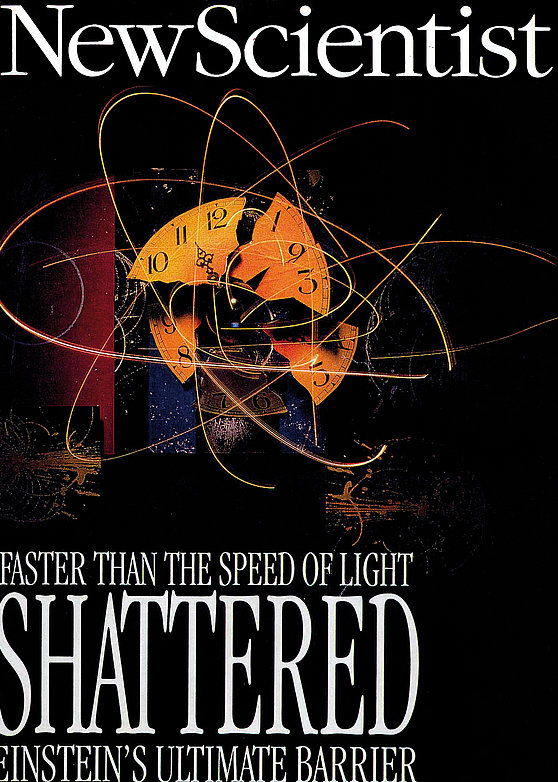 April 1, 1995 // New Scientistfaster than the speed of light
April 1, 1995 // New Scientistfaster than the speed of lightQuantum mechanics have been with us for over sixty years and has been thoroughly put through its paces both experimentally and theoretically. Yet physicists continue to be haunted by its strange implications virtual particles, antimatter, negative energy, Schrödingers cat. Now it appears there is something else to add to the list: light that travels faster than light.